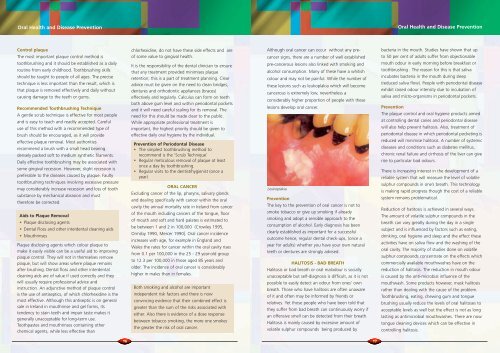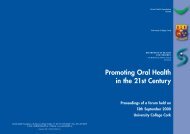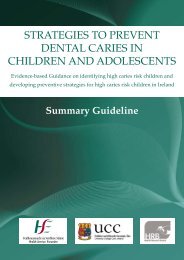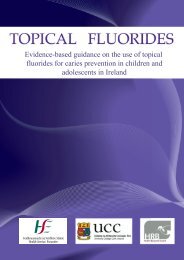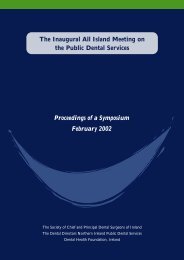Oral Health - Dental Health Foundation
Oral Health - Dental Health Foundation
Oral Health - Dental Health Foundation
Create successful ePaper yourself
Turn your PDF publications into a flip-book with our unique Google optimized e-Paper software.
<strong>Oral</strong> <strong>Health</strong> and Disease Prevention<br />
<strong>Oral</strong> <strong>Health</strong> and Disease Prevention<br />
Control plaque<br />
The most important plaque control method is<br />
toothbrushing and it should be established as a daily<br />
routine from early childhood. Toothbrushing skills<br />
should be taught to people of all ages. The precise<br />
technique is less important than the result, which is<br />
that plaque is removed effectively and daily without<br />
causing damage to the teeth or gums.<br />
Recommended Toothbrushing Technique<br />
A gentle scrub technique is effective for most people<br />
and is easy to teach and readily accepted. Careful<br />
use of this method with a recommended type of<br />
brush should be encouraged, as it will provide<br />
effective plaque removal. Most authorities<br />
recommend a brush with a small head bearing<br />
densely packed soft to medium synthetic filaments.<br />
Daily effective toothbrushing may be associated with<br />
some gingival recession. However, slight recession is<br />
preferable to the diseases caused by plaque. Faulty<br />
toothbrushing techniques involving excessive pressure<br />
may considerably increase recession and loss of tooth<br />
substance by mechanical abrasion and must<br />
therefore be corrected.<br />
Aids to Plaque Removal<br />
• Plaque disclosing agents<br />
• <strong>Dental</strong> Floss and other interdental cleaning aids<br />
• Mouthrinses<br />
Plaque disclosing agents which colour plaque to<br />
make it easily visible can be a useful aid to improving<br />
plaque control. They will not in themselves remove<br />
plaque, but will show areas where plaque remains<br />
after brushing. <strong>Dental</strong> floss and other interdental<br />
cleaning aids are of value if used correctly and they<br />
will usually require professional advice and<br />
instruction. An adjunctive method of plaque control<br />
is the use of antiseptics, of which chlorhexidine is the<br />
most effective. Although this antiseptic is on general<br />
sale in Ireland in mouthrinse and gel forms, its<br />
tendency to stain teeth and impair taste makes it<br />
generally unacceptable for long-term use.<br />
Toothpastes and mouthrinses containing other<br />
chemical agents, while less effective than<br />
chlorhexidine, do not have these side effects and are<br />
of some value to gingival health.<br />
It is the responsibility of the dental clinician to ensure<br />
that any treatment provided minimises plaque<br />
retention; this is a part of treatment planning. Clear<br />
advice must be given on the need to clean bridges,<br />
dentures and orthodontic appliances (braces)<br />
effectively and regularly. Calculus can form on teeth<br />
both above gum level and within periodontal pockets<br />
and it will need careful scaling for its removal. The<br />
need for this should be made clear to the public.<br />
While appropriate professional treatment is<br />
important, the highest priority should be given to<br />
effective daily oral hygiene by the individual.<br />
Prevention of Periodontal Disease<br />
• The simplest toothbrushing method to<br />
recommend is the ‘Scrub Technique’<br />
• Regular meticulous removal of plaque at least<br />
once a day by toothbrushing.<br />
• Regular visits to the dentist/hygienist (once a<br />
year)<br />
ORAL CANCER<br />
Excluding cancer of the lip, pharynx, salivary glands<br />
and dealing specifically with cancer within the oral<br />
cavity the annual mortality rate in Ireland from cancer<br />
of the mouth including cancers of the tongue, floor<br />
of mouth and soft and hard palates is estimated to<br />
be between 1 and 2 in 100,000 (Crowley 1995,<br />
Ormsby 1990, Mercer 1990]. <strong>Oral</strong> cancer incidence<br />
increases with age, for example in England and<br />
Wales the rates for cancer within the oral cavity rises<br />
from 0.1 per 100,000 in the 25 - 29 year-old group<br />
to 12.3 per 100,000 in those aged 85 years and<br />
older. The incidence of oral cancer is considerably<br />
higher in males than in females.<br />
Both smoking and alcohol are important<br />
independent risk factors and there is now<br />
convincing evidence that their combined effect is<br />
greater than the sum of the risks associated with<br />
either. Also there is evidence of a dose response<br />
between tobacco smoking, the more one smokes<br />
the greater the risk of oral cancer.<br />
Although oral cancer can occur without any precancer<br />
signs, there are a number of well established<br />
pre-cancerous lesions also linked with smoking and<br />
alcohol consumption. Many of these have a whitish<br />
colour and may not be painful. While the number of<br />
these lesions such as leukoplakia which will become<br />
cancerous is extremely low, nevertheless a<br />
considerably higher proportion of people with these<br />
lesions develop oral cancer.<br />
Leukoplakia<br />
Prevention<br />
The key to the prevention of oral cancer is not to<br />
smoke tobacco or give up smoking if already<br />
smoking and adopt a sensible approach to the<br />
consumption of alcohol. Early diagnosis has been<br />
clearly established as important for a successful<br />
outcome hence, regular dental check-ups, (once a<br />
year for adults) whether you have your own natural<br />
teeth or dentures are strongly advised.<br />
HALITOSIS - BAD BREATH<br />
Halitosis or bad breath or oral malodour is socially<br />
unacceptable but self-diagnosis is difficult, as it is not<br />
possible to easily detect an odour from ones’ own<br />
breath. Those who have halitosis are often unaware<br />
of it and often may be informed by friends or<br />
relatives. Yet those people who have been told that<br />
they suffer from bad breath can continuously worry if<br />
an offensive smell can be detected from their breath.<br />
Halitosis is mainly caused by excessive amount of<br />
volatile sulphur compounds being produced by<br />
bacteria in the mouth. Studies have shown that up<br />
to 50 per cent of adults suffer from objectionable<br />
mouth odour in early morning before breakfast or<br />
toothbrushing . The reason for this is that saliva<br />
incubates bacteria in the mouth during sleep<br />
(reduced saliva flow). People with periodontal disease<br />
exhibit raised odour intensity due to incubation of<br />
saliva and micro-organisms in periodontal pockets.<br />
Prevention<br />
The plaque control and oral hygiene products aimed<br />
at controlling dental caries and periodontal disease<br />
will also help prevent halitosis. Also, treatment of<br />
periodontal disease in which periodontal pocketing is<br />
reduced will minimise halitosis. A number of systemic<br />
diseases and conditions such as diabetes mellitus,<br />
chronic renal failure and cirrhosis of the liver can give<br />
rise to particular bad odours.<br />
There is increasing interest in the development of a<br />
reliable system that will measure the level of volatile<br />
sulphur compounds in one’s breath. This technology<br />
is making rapid progress though the cost of a reliable<br />
system remains problematical.<br />
Reduction of hatitosis is achieved in several ways.<br />
The amount of volatile sulphur compounds in the<br />
breath can vary greatly during the day in a single<br />
subject and is influenced by factors such as eating,<br />
drinking, oral hygiene and sleep and the effect these<br />
activities have on saliva flow and the washing of the<br />
oral cavity. The majority of studies done on volatile<br />
sulphur compounds concentrate on the effects which<br />
commercially available mouthwashes have on the<br />
reduction of halitosis. The reduction in mouth odour<br />
is caused by the anti-microbial influence of the<br />
mouthwash. Some products however, mask halitosis<br />
rather than dealing with the cause of the problem.<br />
Toothbrushing, eating, chewing gum and tongue<br />
brushing usually reduce the levels of oral halitoses to<br />
acceptable levels as well but the effect is not as long<br />
lasting as antimicrobial mouthwashes. There are now<br />
tongue cleaning devices which can be effective in<br />
controlling halitosis.<br />
16<br />
17


